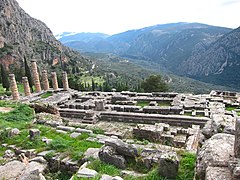
Delphi
Delphi (/ˈdɛlfaɪ, ˈdɛlfi/;[1] Greek: Δελφοί [ðelˈfi]),[a] in legend previously called Pytho (Πυθώ), was an ancient sacred precinct and the seat of Pythia, the major oracle who was consulted about important decisions throughout the ancient classical world. The ancient Greeks considered the centre of the world to be in Delphi, marked by the stone monument known as the Omphalos of Delphi (navel).
For modern town, see Delphi (modern town).Location
Phocis, Greece
Ruins of an ancient sacred precinct
Top of a scarp 500 metres (1,600 ft) maximum off the valley floor
Hellenic Republic
Ministry of Culture and Sports
Accessible for a fee
E. Partida (2012). "Delphi". Odysseus. Ministry of Culture and Sports, Hellenic Republic.
Archaeological Site of Delphi
Cultural
i, ii, iii, iv and vi
1987 (12th session)
According to the Suda, Delphi took its name from the Delphyne, the she-serpent (drakaina) who lived there and was killed by the god Apollo (in other accounts the serpent was the male serpent (drakon) Python).[5][6]
The sacred precinct occupies a delineated region on the south-western slope of Mount Parnassus.
It is now an extensive archaeological site, and since 1938 a part of Parnassos National Park. The precinct is recognized by UNESCO as a World Heritage Site in having had a great influence in the ancient world, as evidenced by the various monuments built there by most of the important ancient Greek city-states, demonstrating their fundamental Hellenic unity.[7]
Adjacent to the sacred precinct is a small modern town of the same name.
Delphi and the Delphic region[edit]
Today Delphi is a municipality of Greece as well as a modern town adjacent to the ancient precinct. The modern town was created after removing buildings from the sacred precinct so that the latter could be excavated. The two Delphis, old and new, are located on Greek National Road 48 between Amfissa in the west and Livadeia, capital of Voiotia, in the east. The road follows the northern slope of a pass between Mount Parnassus on the north and the mountains of the Desfina Peninsula on the south. The pass is of the river Pleistos, running from east to west, forming a natural boundary across the north of the Desfina Peninsula, and providing an easy route across it.
On the west side the valley joins the north–south valley between Amfissa and Itea.
On the north side of the valley junction a spur of Parnassus looming over the valley made narrower by it is the site of ancient Krisa, which once was the ruling power of the entire valley system. Both Amphissa and Krissa are mentioned in the Iliad's Catalogue of Ships.[11] It was a Mycenaean stronghold. Archaeological dates of the valley go back to the Early Helladic. Krisa itself is Middle Helladic.[12] These early dates are comparable to the earliest dates at Delphi, suggesting Delphi was appropriated and transformed by Phocians from ancient Krisa. It is believed that the ruins of Kirra, now part of the port of Itea, were the port of Krisa of the same name.[13]







